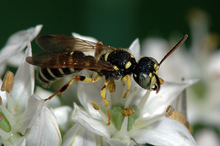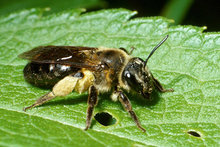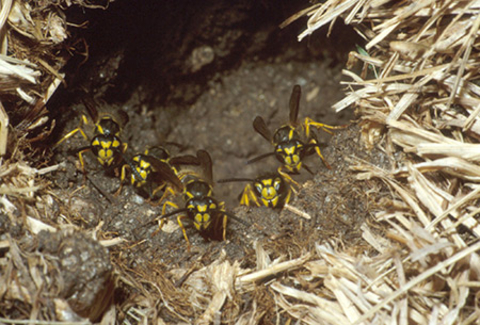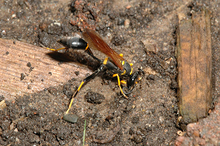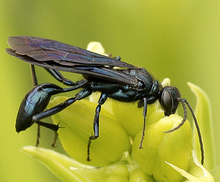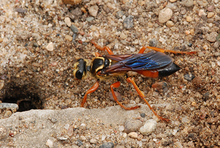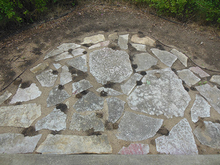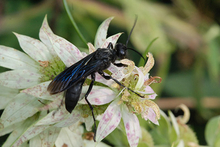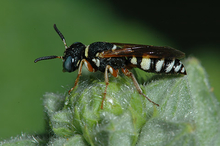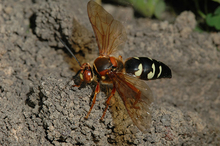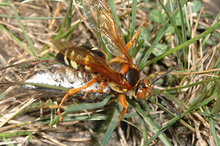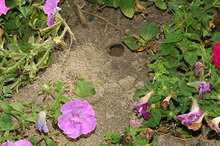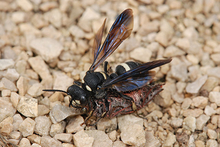Quick facts
- Solitary wasps are common beneficial insects in landscapes.
- They hunt and capture other insects or spiders to feed their young.
- They are not aggressive toward people and rarely sting.
- Solitary wasps should be tolerated and ignored whenever possible.
Identifying solitary wasps
Solitary wasps (also called hunting wasps) are a group of related insects primarily consisting of the thread-waisted wasps (Sphecidae) and digger wasps (Crabronidae).
They have the following characteristics:
- Smooth and shiny body; few hairs.
- Body ranges from slender to stout.
- Vary in size from less than 1/2 inch long to 1-1/2 inches long.
- Vary in color: black and yellow, black and orange, iridescent black or purple.
Insects that may be confused with solitary wasps
Some solitary wasps may be confused with bees. However, bees have hairy bodies and legs, and often are seen carrying balls of pollen on their hind legs. Solitary wasps have few hairs on their bodies or legs.
Solitary wasps, especially digger wasps, may also be mistaken for yellowjackets, although most solitary wasps are larger than yellowjackets.
Solitary wasps and yellowjackets both build nests in the ground. Ground-nesting solitary wasps often build nests in groups with each wasp having its own individual nest. Yellowjackets live together in one nest with many workers going in and out of the single nest opening.
Biology of solitary wasps
Thread-waisted wasps and digger wasps are commonly seen from June through August.
Most solitary wasps nest in the ground. However, some build nests made of mud and a few nest in cavities, like hollow plant stems or cavities in wood.
- There is one female wasp in each nest.
- Some species live gregariously, meaning there are many nests in a small area.
Adult solitary wasps feed on nectar and are commonly seen around flowers. They prey on insects or spiders to feed to their young. A particular solitary wasp attacks a specific type of insect.
- They sting and paralyze their prey. They either drag them to their nest or pick them up and fly back with them.
- The females bring a number of prey back to its nest. The larvae feed on the immobilized prey that has been provided for them.
The adult females die by the end of the summer. The larvae eventually pupate and emerge the following summer. There is one generation each year.
Importance of solitary wasps
Natural control
Solitary wasps prey on insects or spiders which helps keep those arthropod populations in check.
Pollination
Solitary wasps can move pollen when they visit flowering plants. Although wasps are not as efficient pollinators as bees, pollen grains can stick to a wasp’s body and transfer between flowers.
Nuisance
Solitary wasps can be a nuisance and cause concern when they nest in lawns or gardens, especially when large numbers are present. They can potentially sting to protect themselves.
- Fortunately, they are not aggressive to people and there is little risk from them.
- They do not defend their nests and avoid people when possible.
- They can sting to protect themselves if they are physically handled.
- Yellowjackets protect their nests and are much more likely to sting people.
How to live with solitary wasps
Managing solitary wasps is difficult and is unnecessary. Remember, these wasps are beneficial with little risk of stings.
If you find solitary wasps in your landscape:
- Ignore and tolerate them whenever possible.
- Solitary wasps are active for just a few weeks.
- They only live one season and do not reuse nests year after year.
- Solitary wasps are not aggressive and are unlikely to sting.
Solitary wasps can sometimes still cause concern when found nesting where people, especially children, are present. In cases where it is difficult for residents to ignore the nests, there are few options that can be attempted.
Management options in turf
In lawn areas, the best management is to treat each individual nest with insecticidal dust labeled for ground-nesting insects, e.g. permethrin. Spraying the nest area with a liquid insecticide is not very effective.
Management options in playgrounds or sandboxes
Sand wasps or other digger wasps that nest in sandboxes or playgrounds are difficult to manage once they have started nesting. Using a pesticide where children play is not recommended.
It might be possible to discourage wasps from nesting in an area.
- Frequent raking of the nesting area may cause them to nest somewhere else.
- Laying a tarp over the nests for several days may also discourage them from that area.
Mud dauber nests
When mud dauber nests are found on a home, ignore them or remove the nests with a putty knife. They do not defend their nests so there is little to no risk of stings.
CAUTION: Mention of a pesticide or use of a pesticide label is for educational purposes only. Always follow the pesticide label directions attached to the pesticide container you are using. Be sure that the area you wish to treat is listed on the label of the pesticide you intend to use. Remember, the label is the law.
Thread-waisted wasps
Thread-waisted wasps (Sphecidae) have a conspicuous, long, thin segment called a petiole between the abdomen and thorax (it is actually part of the abdomen). This gives the body its "thread-waisted" appearance. Common colors are black with yellow or orange or metallic purple or black.
Sceliphron caementarium
Identification
Black and yellow mud daubers are about 3/4 to 1 inch long. They have a black head and a black thorax and abdomen with yellow markings. They have black and yellow legs. The wings range from orangish to black.
Biology
These wasps build their nests from moist mud balls they make from the soil. They are found in sheltered locations and are often on the sides of homes.
Prey
Spiders
When active
June through August
Chalybion californicum
Identification
Blue mud daubers are about an inch long. They have a blue-black body and wings that are somewhat iridescent.
Biology
Blue mud daubers reuse and renovate old mud dauber nests as their own, including black and yellow mud daubers. However, instead of gathering mud like black and yellow mud daubers, they carry water to a source of soil near its nest to moisten it and then use the mud to build their nest.
Prey
Spiders. They often land on webs, shake them, and then capture spiders when they come out to investigate.
When active
May to August
Sphex ichneumoneus
Identification
A great golden digger wasp is just over an inch in length. It has a black and yellow head and thorax with a reddish-orange and black abdomen, reddish-orange legs, and dark wings.
Biology
They build their nests in the ground and are usually gregarious with many nests in the same area.
Prey
Katydids
When active
July to September
Sphex pensylvanicus
Identification
Great black wasps are large, up to nearly 1-1/2 inches long, with black bodies and wings that are black and dark blue.
Biology
They nest in soft soil in fields and gardens.
Prey
Katydids
When active
July to August
Ammophila spp.
Identification
This wasp is about 5/8 to 1 inch long. They are black with red or orange markings.
Biology
These wasps are ground nesters but typically are not gregarious, choosing to nest by themselves. They construct their nests and then temporarily seal them just before searching for food.
Prey
Hairless caterpillars and sawfly larvae
When active
July and August
Digger wasps
Digger wasps (Crabronidae) are more compact and robust than their thread-waisted cousins and are usually black and yellow with striped abdomens, resembling yellowjackets.
Bembix americana spinole
Identification
American sand wasps are about 1/2 to 5/8 inch long. They have a black head. Their thorax is also black with mostly yellow legs. They have a black abdomen with five white to yellow bands.
Biology
Females dig nests in the sandy ground including beaches, playgrounds, and sandboxes and are gregarious with many nests in a small area.
Prey
Flies
When active
June to August
Philanthus spp.
Identification
Bee wolves are about 3/4 inch long. They have a black head, a black thorax with yellow markings and a black abdomen with yellow bands on their abdomen.
Biology
They nest in the ground in soil that is not too sandy or with too much clay.
Prey
Bees, including honey bees and sweat bees
When active
June to September
Sphecius speciosus
Identification
Cicada killers are large, about 1 to 1 1/2 inches long. They have a dark colored head, a black and reddish-brown thorax, and a black abdomen with yellow bands. They also have reddish-brown legs and amber-colored wings.
Biology
Nests are found in sandy areas in fields, lawns and gardens. They often nest in large numbers in a given area. The males are very territorial and will buzz other males, as well as people, to discourage them from nests; fortunately, they lack a stinger and cannot sting.
Prey
Cicadas
When active
July and August
Cerceris spp.
Identification
Weevil wasps are about 1/2 - 5/8 inch long. They are mostly black with yellow markings on the head and thorax and yellow bands on the abdomen.
Biology
Weevil wasps construct nests in the soil and are usually gregarious.
Food
Mostly beetles, especially weevils and leaf beetles. The smokey-winged beetle bandit, C. fumipenis, captures buprestid beetles, including emerald ash borers.
When active
June to September
Reviewed in 2021


